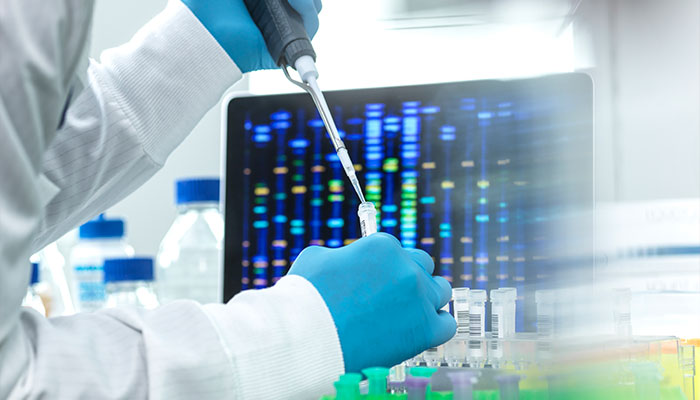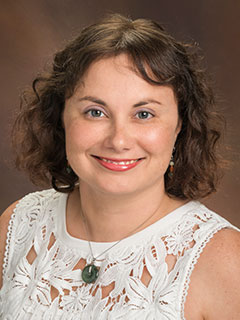HOW CAN WE HELP YOU? Call 1-800-TRY-CHOP
In This Section
Exploring How Early Life Injuries Drive Epigenetic Changes

CHOP scientists are exploring the potential epigenetic pathways of neonatal and prenatal brain injuries.
limjr [at] chop.edu (By Jillian Rose Lim)
Watching babies go from nestled newborns to bright beings who talk and walk is a transition nothing short of “amazing” for Ana Cristancho, MD, PhD.
In fact, this remarkable development is exactly what led the Children’s Hospital of Philadelphia neurologist to fall in love with neonatal neurology not just as a physician, but also as a scientist. When she isn’t seeing patients in clinic, you will find Dr. Cristancho in the lab exploring how this transition happens at a molecular and cellular level. Specifically, she is interested in how early-life experiences can disrupt the brain’s delicate development.
Now, a new honor from the Harold Amos Medical Faculty Development Program of the Robert Wood Johnson Foundation (RWJF) allows Dr. Cristancho to probe that query further. With the award’s four-year support, she has embarked on a study of how infant hypoxia, or low oxygen in pregnancy, and other early-life injuries can cause long-term effects. Though clinicians can see no structural changes in the brain, the long-term consequences of prenatal and neonatal brain injuries can range from cerebral palsy to autism to epilepsy, among others.
The topic is a fitting one for the Harold Amos award, which is rooted in support for historically disadvantaged populations. Because families from underrepresented communities are less likely to have access to quality prenatal care, infants from these populations are disproportionately impacted by these early-life injuries.
“This award is a tremendous honor,” Dr. Cristancho said. “Dr. Harold Amos was a pioneer in increasing diversity amongst faculty and in academia, and this award has been held by many people who have gone on to be leaders in their field. To be welcomed by this organization is a tremendous honor. It really speaks to me being able to help [underrepresented] communities through science and trying to affect change for them in the long run.”

Ana Cristancho, MD, PhD
Early Brain Development
Dr. Cristancho’s research focuses on a specific type of neural change that may occur with prenatal or postnatal hypoxia: epigenetics.
Scientists have long studied epigenetic changes, or how the external outputs of a person’s experiences and environment switch gene activity “on” or “off.” And because the brain develops most rapidly early in life, it is well-established that epigenetic changes play an important part in how a child’s brain develops. The infant brain is particularly sensitive to modifications that can be driven by factors like toxin exposure, nutrition, and stimulating or traumatic environments.
When it comes to epigenetic pathways carved out by infant injuries, however, scientists know relatively little.
“We know that you need the right genes to be turned on and off during development to have a brain cell work normally,” Dr. Cristancho said. “But what is not well understood is what happens when external forces like hypoxia, inflammation, or other outside signals disrupt which pattern of switches are turned on and off. We also need to learn more about whether that disruption could potentially be reversed to improve long-term outcomes.”
With support from the Harold Amos award, Dr. Cristancho and her lab will be able to develop more cell culture models to study these pathways in detail.
Looking Across the Lifespan
Ultimately, Dr. Cristancho aims for her research to set the foundation for the development of targeted treatments for the consequences of early-life injury, of which there currently are none.
“In this line of research, we think about these pathways not only in terms of how they are altered at the time of injury, but also how they might continue to be altered, and provide opportunities for intervention throughout a child’s lifespan,” Dr. Cristancho said. “Right now, when an infant experiences something like hypoxia in utero, we provide therapies and supportive care, but we do not have treatments that could potentially reverse the molecular effects.”
For Dr. Cristancho, the most exciting thing to come out of her research would be an in-clinic intervention that would improve outcomes. What such a treatment would look like remains to be seen, but she can ruminate on the possibilities.
“There are increasingly new and exciting nanotechnology platforms and CRISPR technologies for epigenome editing,” Dr. Cristancho said, adding that the further development of these therapies ultimately depend on the future direction of biotechnology.
Buoyed by her passion and the ability to work on the cutting edge of her field with the support of the RWJF award, Dr. Cristancho is bound to contribute to a brighter future for children following early-life brain injury.